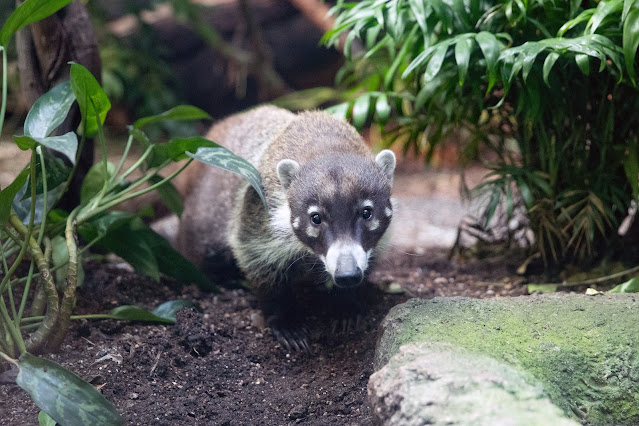Posted by Elizabeth Bacher, Communications
Photos by Jeremy Dwyer-Lindgren
Co-WHAT-i is a coati?
 |
| Hello, cutie coati! |
If you’ve visited the recently reopened Tropical Rain Forest building, you may have noticed a couple fresh faces there! A pair of white-nosed coatis, Onyx and Pearl, are the first of their species to live at Woodland Park Zoo.
The white-nosed coati (pronounced ko-WAT-tee) is one of several recognized species of coatis. It is a house cat-sized mammal that looks a little like a raccoon—no surprise since they’re related and share the same taxonomic family classification. In the wild, the habitat of the white-nosed coati includes tropical and sub-tropical broadleaf forests ranging from Arizona down through Mexico and Central America and very top of South America. They’re not considered to be endangered in most of their range, but scientists believe their populations are decreasing due to habitat loss and deforestation.
 |
| White-nosed coati, Onyx, explores his new habitat. |
Coatis have a narrow flexible snout and a semi-prehensile tail, which means their tail can help them balance on a branch or lightly grasp it, but they can’t grip tightly with it or hang from it. Unlike nocturnal raccoons which are mostly active at night, coatis tend to spend their evenings resting and snoozing in nests that they build high up in the canopy.
 |
| Peek-a-boo! Coatis tend to spend their evenings resting and snoozing in nests high up in the canopy. |
Coatis are mostly diurnal—active during the day—and the daytime is all about finding food. That’s when they use that long flexible nose to probe through rocks and leaves on the forest floor. Almost anything they find could be on the menu, but coatis mostly feed on fruit, bugs, bird eggs, and sometimes they will prey on rodents, lizards or small snakes.
 |
| Coatis have long, flexible snouts that allows them to probe through rocks and leaves on the forest floor for fruit, bugs, bird eggs or small prey like rodents, lizards and snakes. |
At Woodland Park Zoo, Onyx and Pearl feast on daily offerings of high-protein kibble, along with a variety of fruits and vegetables including apples, pears, bananas, grapes, yam, carrots and more. But our awesome animal keepers tell us their favorite treats are bugs (beetle larvae and crickets) and egg yolks. YUM!
Onyx and Pearl are still acclimating to their new habitat in the Tropical Rain Forest building and they’re a bit shy. Both of them came to Woodland Park Zoo only a couple months ago from zoological institutions in Mexico and we appreciate your patience as they slowly get more comfortable navigating through their exhibit. Right now, Onyx is the bolder of the two, and if you come to visit, he’s the one you’ll most likely spot. Onyx has just turned 2 years old (his birthday was June 10) which is the age at which males are considered to be sexually mature. He is very curious and the first to investigate any enrichment of new foods or smells! Pearl, who is 9 years old, is definitely quieter and more reserved. She mostly stays hidden when animal keepers offer her food and will slowly come out later to “inspect” what tasty treats are waiting for her.
Onyx and Pearl are still acclimating to their new habitat in the Tropical Rain Forest building and they’re a bit shy. Both of them came to Woodland Park Zoo only a couple months ago from zoological institutions in Mexico and we appreciate your patience as they slowly get more comfortable navigating through their exhibit. Right now, Onyx is the bolder of the two, and if you come to visit, he’s the one you’ll most likely spot. Onyx has just turned 2 years old (his birthday was June 10) which is the age at which males are considered to be sexually mature. He is very curious and the first to investigate any enrichment of new foods or smells! Pearl, who is 9 years old, is definitely quieter and more reserved. She mostly stays hidden when animal keepers offer her food and will slowly come out later to “inspect” what tasty treats are waiting for her.
 |
| Hello, Onyx! |
Next time you come to the zoo, make sure to stop by the Tropical Rain Forest building to catch a peek of Onyx or Pearl. And remember, every time you visit them or any of our animals, a portion of your admission or membership helps us to provide amazing care for all our animals and to support our wildlife conservation partners in the Pacific Northwest and around the world!
 |
| That face! |
More about coatis
- Coatis often walk with their tails high up in the air—a great adaptation for balancing while climbing through the trees
- Coatis have double-jointed ankles that help them quickly climb down from trees headfirst.
- Males tend to be solitary (except during breeding season), but females and youngsters can socialize in larger groups—called bands—with as many as 20 members or more.
Comments
Post a Comment